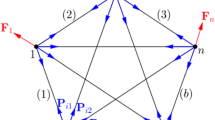Abstract
We propose a fictitious domain method for topology optimization in which a level set of the topological derivative field for the cost function identifies the boundary of the optimal design. We describe a fixed-point iteration scheme that implements this optimality criterion subject to a volumetric resource constraint. A smooth and consistent projection of the region bounded by the level set onto the fictitious analysis domain simplifies the response analysis and enhances the convergence of the optimization algorithm. Moreover, the projection supports the reintroduction of solid material in void regions, a critical requirement for robust topology optimization. We present several numerical examples that demonstrate compliance minimization of fixed-volume, linearly elastic structures.
Similar content being viewed by others
References
Allaire G, Jouve F, Toader A (2002) A level-set method for shape optimization. C R Math Acad Sci 334(12):1125–1130
Allaire G, de Gournay F, Jouve F, Toader A (2004a) Structural optimization using topological and shape sensitivity via a level set method. Internal report 555, Ecole Polytechnique
Allaire G, Jouve F, Toader A (2004b) Structural optimization using sensitivity analysis and a level-set method. J Comput Phys 194(1):363–393
Belytschko T, Xiao S, Parimi C (2003) Topology optimization with implicit functions and regularization. Int J Numer Methods Eng 57:1177–1196
Bendsøe M (1989) Optimal shape design as a material distribution problem. Struct Optim 1:193–202
Bendsøe MP, Haber RB (1993) The michell layout problem as a low volume fraction limit of the perforated plate topology optimization problem: An asymptotic study. Struct Optim 6:263–267
Bendsøe MP, Sigmund O (2003) Topology optimization. Springer, Berlin Heidelberg New York theory, methods and applications
Bloomenthal J (1988) Polygonization of implicit surfaces. Comput Aided Geom Des 5(4):341–355
Céa J, Garreau S, Guillaume P, Masmoudi M (2000) The shape and topological optimizations connection. Comput Methods Appl Mech Eng 188:713–726
Eschenauer HA, Kobelev V, Schumacher A (1994) Bubble method for topology and shape optimization of structures. Struct Optim 8:42–51
Garreau S, Guillaume P, Masmoudi M (2001) The topological asymptotic for PDE systems: the elasticity case. SIAM J Control Optim 39(6):1756–1778 (electronic)
Haber RB, Jog CS, Bendsøe MP (1996) A new approach to variable-topology shape design using a constraint on perimeter. Struct Optim 11:1–12
Kohn R, Strang G (1986) Optimal design and relaxation of variational problems. Commun Pure Appl Math 39(1):1–25 (part I), 139–182 (part II), and 353–357 (part III)
Mei Y, Wang X (2004) A level set method for structural topology optimization and its applications. Adv Eng Softw 35:415–441
Norato J, Haber R, Tortorelli D, Bendsøe MP (2004) A geometry projection method for shape optimization. Int J Numer Methods Eng 60(14):2289–2312
Olhoff N, Bendsøe MP, Rasmussen J (1991) On CAD-integrated strutural topology and design optimization. Comput Methods Appl Mech Eng 89(1–3):259–279
Pedersen P (1989) On optimal orientation of orthotropic materials. Struct Optim 1(2):101–106
Pedersen P (1990) Bounds on elastic energy in solids of orthotopic materials. Struct Optim 35(1):55–63
Pedersen P (1998) Some general optimal design results using anisotropic, power law nonlinear elasticity. Struct Optim 15(2):73–80
Pedersen P (2003a) A note on design of fiber-nets for maximum stiffness. J Elast 73(1):127–145
Pedersen P (2003b) Optimal designs—structures and materials—problems and tools. http://www.fam.web.mek.dtu.dk/pp.html
Pedersen P, Pedersen N (2005) An optimality criterion for shape optimization in eigenfrequency problems. Struct Multidiscipl Optim 29(6):457–469
Rozvany G (2000) Basic geometrical properties of exact optimal composite plates. Comput Struct 76(1–3):263–275
Rozvany G, Zhou M (1991) Applications of the coc method in layout optimization. Comput Struct 76(1–3):263–275
Sokołowski J, Zochowski A (1999) On the topological derivative in shape optimization. SIAM J Control Optim 37(4):1251–1272 (electronic)
Wang MY, Wang X, Guo D (2003) A level set method for structural topology optimization. Comput Methods Appl Mech Eng 192:227–246
Zhou M, Rozvany G (2001) On the validity of eso type methods in topology optimization. Struct Optim 21:80–83
Author information
Authors and Affiliations
Corresponding author
Rights and permissions
About this article
Cite this article
Norato, J.A., Bendsøe, M.P., Haber, R.B. et al. A topological derivative method for topology optimization. Struct Multidisc Optim 33, 375–386 (2007). https://doi.org/10.1007/s00158-007-0094-6
Received:
Revised:
Published:
Issue Date:
DOI: https://doi.org/10.1007/s00158-007-0094-6




